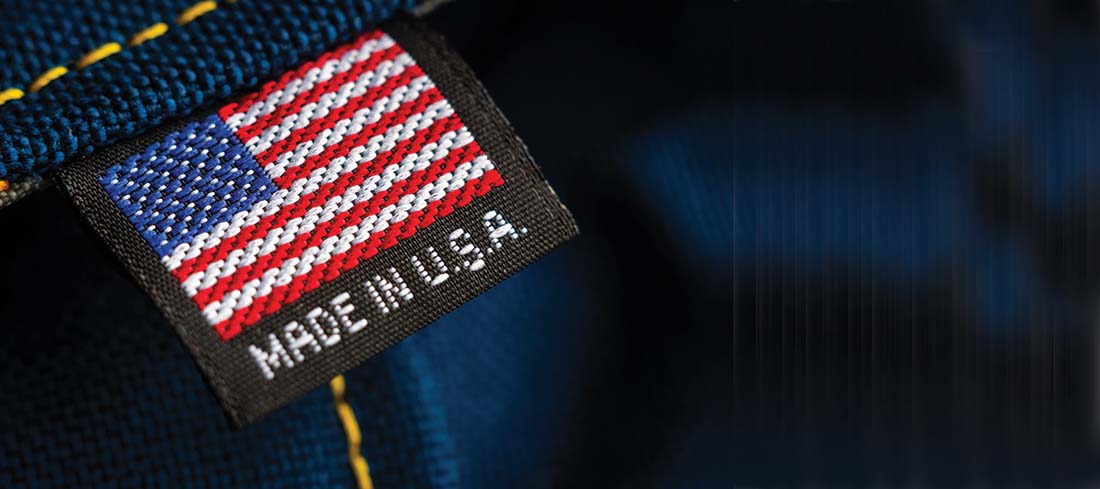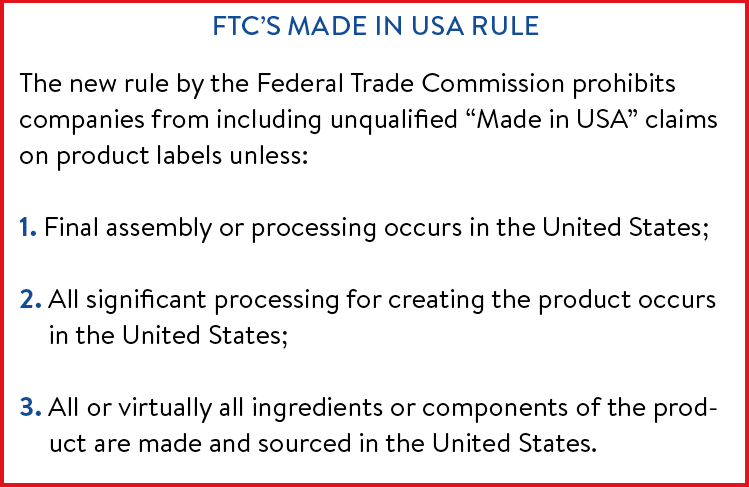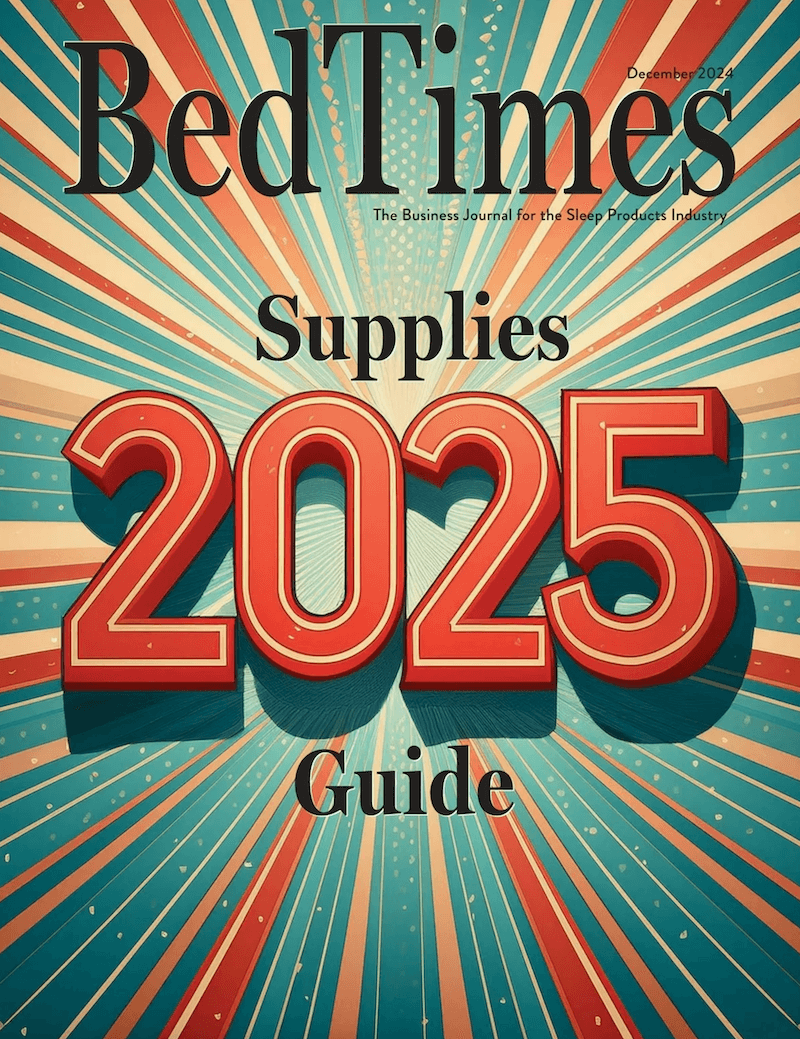Patriotism is a powerful marketing tool, but use it accurately

Before you put Made in America on your products, use caution. You may think your products qualify, but they may not, according to new standards established by the Federal Trade Commission.
In the past several years, the commission has started cracking down on manufacturers claiming their products are made in America when they’re made abroad. In some cases, companies faced huge penalties for not complying with the FTC rules.
According to the FTC: “Made in USA means that ‘all or virtually all’ the product has been made in America. That is, all significant parts, processing and labor that go into the product must be of U.S. origin. Products should not contain any — or should contain only negligible — foreign content.”
That’s the definition of an “unqualified claim.” The FTC also has established a “qualified claim,” which must include a disclaimer, such as “Made in USA with U.S. and imported components.”
In addition to labels, the FTC prohibits manufacturers from making untrue, misleading or unsubstantiated country-of-origin claims in marketing materials about any product or service. (See Made in USA: Ask the Expert for a more detailed explanation.)
“Labeling your product as Made in USA can be an important product attribute for some consumers and retailers,” says Ryan Trainer, president of the International Sleep Products Association. “But the rules that govern when you can use this label can be tricky. It is important that bedding and component manufacturers know the rules and communicate those requirements clearly to all levels of company management, from those involved with sourcing inputs to manufacturing the product and marketing it. Recent experience shows that mattress companies that fail to heed this advice can violate these rules and incur costly monetary penalties.”
For example, late last year the FTC alleged that a mattress company repeatedly made false claims that its products were “proudly made with 100% USA-made premium quality materials.” In fact, the FTC found that all or significant portions of the mattresses were sourced with foreign materials and were always finished overseas.
Under the terms of a consent order, the company must pay $753,000, notify customers of the false claims, and maintain certain records and file compliance reports with the FTC for the next 20 years. This action follows a 2018 settlement between the FTC and the same company involving similarly false “Made in USA” claims.
“At no time in our history has ‘Made in America’ been more important to the health and stability of our country, communities and families.”
MadeinAmerica.org
Do consumers really care?
Yes, they care that a product is made in America more than ever. The spread of Covid-19 caused massive global gridlock in the supply chain, creating the perception that if a consumer wants certain goods delivered in a timely fashion — especially furniture, for example — they better be made in America.
The Made in USA label symbolizes traditional, positive ideals: high quality and supporting U.S. companies and jobs. With the spread of the virus, some consumers naturally shifted toward buying American-made goods.
According to the nonprofit group MadeinAmerica.org: “At no time in our history has ‘Made in America’ been more important to the health and stability of our country, communities and families. Twenty years of offshoring manufacturing has shown that America’s supply chain is weak enough when responding to a crisis like the Covid-19 pandemic. Increasing domestic manufacturing and buying American-made products energizes and revitalizes jobs across our country.”
In an August 2020 survey by the Better Sleep Council, the consumer education arm of ISPA, three in 10 consumers said that a mattress being made in the USA would be an important feature they would consider when purchasing a new mattress. In the “reputation” portion of the survey, 30% considered made in America important, far greater than the 17% that considered brand name important. (The BSC conducted this survey online in August 2020 from a national sample of 1,003 respondents who participate in mattress-purchasing decisions.)
Handle “America” with care
Marketers have recognized the power of using the word “America” as far back as 1941 when the first TV advertisement aired before a Brooklyn Dodgers and Philadelphia Phillies baseball game. The 10-second spot (which cost only $9) stated, “America runs on Bulova time.”
Using the word “America” still works. “Where a brand can establish emotional connections with a value as powerful as ‘patriotism,’ consumers will engage more strongly, believe more about the brand and behave more positively toward the brand. … In most cases, six times more,” according to Robert Passikoff, president of Brand Keys, a New York-based brand engagement and customer loyalty research consultancy.

The good news is that even if your product is not made in America per the FTC rule for unqualified claims, you can still make a qualified claim. For example, an iPhone or iPad label might state it is, “Designed by Apple in California. Assembled in China.”
According to the FTC, a qualified claim “describes the extent, amount or type of a product’s domestic content or processing; it indicates that the product isn’t entirely of domestic origin.” A label might state, “60% U.S. content,” or “Made in USA of U.S. and imported parts.”
Still, the FTC warns to avoid qualified claims unless the product contains a significant amount of U.S. content or U.S. processing. The qualified claims must be as truthful and substantiated as an unqualified claim in which the product is “all or virtually all” made and sourced in the United States.
Perhaps the best policy when considering a made in America claim is to consult with an attorney. The law firm of Cavitch, Familo & Durkin in Cleveland sums it up nicely: “Failure to comply with laws regulating a country of origin’s claim may result in fines, regulation, and litigation costs and damage of a company’s good will. … With products’ contents and components’ costs changing constantly, companies should regularly review their products’ information to make sure the products are really ‘Made in USA.’ ”
Made in USA: Ask the Expert
Attorney Yohai Baisburd offers guide to the rules
Labeling or promoting a product as Made in USA can go a long way with today’s consumers. But manufacturers must be vigilant when making a Made in USA claim to meet all the Federal Trade Commission standards — or else face heavy fines and penalties.
BedTimes interviewed Yohai Baisburd, a partner in Cassidy Levy Kent in Washington, D.C., about how manufacturers can protect themselves against complaints. Baisburd counsels companies, trade associations and governments in a variety of international trade matters in the United States and abroad. His practice focuses on trade remedy (antidumping, subsidies, safeguards) litigation, and import/export compliance and enforcement proceedings. Here’s his guidance on how to safely claim “Made in USA.”

BedTimes: What can mattress manufacturers do to protect themselves when making a Made in USA claim?
Baisburd: Know the rules. The Federal Trade Commission makes and enforces the Made in USA rules. The FTC has established two types of Made in USA claims. The first is an “unqualified claim” where someone simply says, “Made in USA,” “Made in America” or something along those lines. The second is a “qualified claim,” which includes a disclaimer such as “Made in USA with U.S. and imported components,” “Made in USA with X% U.S. content” or some other qualification.
The other wrinkle is that a “Made in USA” claim can be either express or implied. The express claims are easy to identify — the manufacturer includes a qualified or unqualified claim on the product. Implied claims arise based on advertising or statements that imply U.S. origin without expressly labeling the product. For example, touting on your website that your factory is located in Anytown, USA, and the products are proudly made by American workers.
Be accurate. The FTC is trying to protect consumers by providing them with accurate information. If your product includes non-U.S. origin components, say so through a qualified claim. If the product is designed in the U.S., but manufactured abroad, say that. If the cover is imported, but all the other components are U.S. origin, say something like “Assembled in the U.S. with U.S. components and an imported cover.”
BedTimes: We understand that it’s easy to get confused between a qualified claim and an unqualified claim. What is the key difference between the two?
Baisburd: An unqualified claim — “Made in America” — means that “all or virtually all” the content is U.S. origin. It is a very high standard that can lead to a lot of confusion, especially with respect to implied claims. In recent years the White House has showcased products on the White House lawn during “Made in America” week. The White House website and social media accounts all promoted “Made in America” products — an unqualified claim. Here is the problem: Several of those products contained significant non-U.S. origin content so at most they should have used a qualified claim such as “Made in America with U.S. and imported components.” Unless you are the White House, if your truck contains over 35% non-U.S. origin or your cosmetics contain aloe from a “fair-trade producer” do not make an express or implied unqualified claim of U.S. origin.
BedTimes: Some states have their own Made in America programs, with different criteria from the federal standard. How can mattress manufacturers navigate between state programs and the FTC standard?
Baisburd: Know the rules. You could qualify for a state program such as Made in Alaska, while being in violation of the FTC rules. The Made in Alaska program requires that 51% or more of the product be produced in Alaska. Let’s assume a product is 60% Alaskan content and 40% imported components. Labeling that mattress as “Made in Alaska” may be OK under the state program, but the FTC would consider that an implied unqualified claim of U.S. origin. You can comply with both entities by making a qualified claim, such as “Made in Alaska with U.S. and imported components.”
BedTimes: In addition to the federal and state programs, free trade agreements introduce different international standards for Made in USA claims. How should mattress manufacturers handle these separate international agreements?
Baisburd: Know the rules. The United States applies different origin rules for different purposes. The U.S.–Mexico–Canada agreement that replaced NAFTA contains its own rules for identifying U.S. origin products. Those rules are very different from the FTC “Made in USA” rules. As a result, a mattress that should be labeled as “Made in USA” under the USMCA rules for sale in Toronto or Tijuana might not be eligible to be labeled as “Made in USA” under the FTC rules for sale just across the border in San Diego.
BedTimes: How is the FTC Made in USA standard enforced?
Baisburd: The FTC Made in USA standards generally are enforced through administrative actions at the FTC. The FTC often initiates enforcement actions after receiving complaints from consumers and/or competitors. FTC staff will then generally issue requests for information and documents to determine whether there is evidence of an actual violation. In nearly all cases, the enforcement staff shares with the investigated companies a draft complaint that would be filed with the FTC for violations of the Federal Trade Commission Act. The FTC and parties generally negotiate a consent agreement, which often includes a monetary penalty and commitments to not engage in prohibited acts. If the FTC issues a complaint before the consent agreement is reached, any future violations of the consent agreement can result in civil penalties of over $40,000 per violation.
BedTimes: Is it necessary to consult with an attorney before making a Made in USA claim?
Baisburd: Seeking legal advice before making a Made in America claim can help avoid some of the pitfalls and penalties I’ve mentioned above. The FTC also provides guidance to businesses on its website, FTC.gov.






